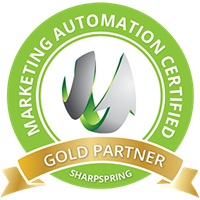That’s a question I get asked often, and it honestly has multiple answers, but one of the better explanations I frequently share is from our downloadable guide, ‘Getting Started with Email Marketing Automation’:
“Marketing automation refers to technology that automatically serves content to target audiences. Most automation tools do this through digital workflows focused on a specific channel. Sophisticated marketing automation will place prospects into specific workflows based on actions, helping your sales and marketing team gain a clear understanding of how your audience engages with your brand.”
I think all too often, people view marketing automation as a simple platform to execute email drip campaigns, but good marketing automation connects the dots between all of your platforms. Integrating email, social media, website traffic, ad campaigns, and even chatbots on your site.
(We happen to specialize in marketing automation and manage it for a number of our clients. One thing we can’t stress enough is that with any platform, the strategy that you put into place to support it is crucial to success.)
So, it’s about meeting your customer across channels, serving them the right content at the right time to help educate them about your product or service, and showing them the value you offer as they go through their decision process. So it’s not just blindly emailing messaging over time, it’s actively engaging with your prospective customers and leads. How? Well, in the guide we explain it this way:
“Marketing automation operates on a “trigger and action” framework. In essence, a prospect does something to engage with your brand, which triggers an automated response from your brand. For example, let’s say a prospect downloads a white paper from your site. This is a pretty common trigger in inbound marketing, which usually results in the prospect receiving an email or follow-up call.”
But it’s not just an instant phone call the moment someone downloads a white paper. A good marketing automation strategy will help score the intent of the lead. It will work to identify if they are qualified. Do they have purchase intent? Do they understand the price range and have the ability to invest in it? How soon are they looking to buy? Answers to these questions help to determine a lead score for each prospect, and it helps determine who is ready to buy, and who needs more time. That’s crucial in order to know who to spend time with first. But how? Again, we explain:
“Automation methodology can get pretty sophisticated—for instance, let’s go back to the prospect who downloaded a white paper as a trigger, and receives an email as the response to that trigger. Based on how they engage with that email, your automation workflows can branch out accordingly. If they open it and click through to your site, they’re a “hotter” lead who is more likely to benefit from decision-level sales material or promotions. If they open the email and don’t click through, they might benefit more from additional awareness and consideration level content. If you send them multiple emails that don’t get opened, it might make sense to put them into a more periodic awareness-based drip so that you remain present without annoying them.”
So a good way to look at marketing automation is as a platform that connects the dots between all of your marketing efforts and your CRM, giving you a way to automate lead scoring and qualification while moving serious leads down your funnel until the moment of purchase.
Are you using automation currently? How is it working out for you? Do you have questions? Need a little advice? I’m happy to help. Just leave a comment below! Also, if you would like to download our free guide, you can get it here: Download ‘Getting Started with Email Marketing Automation’.

